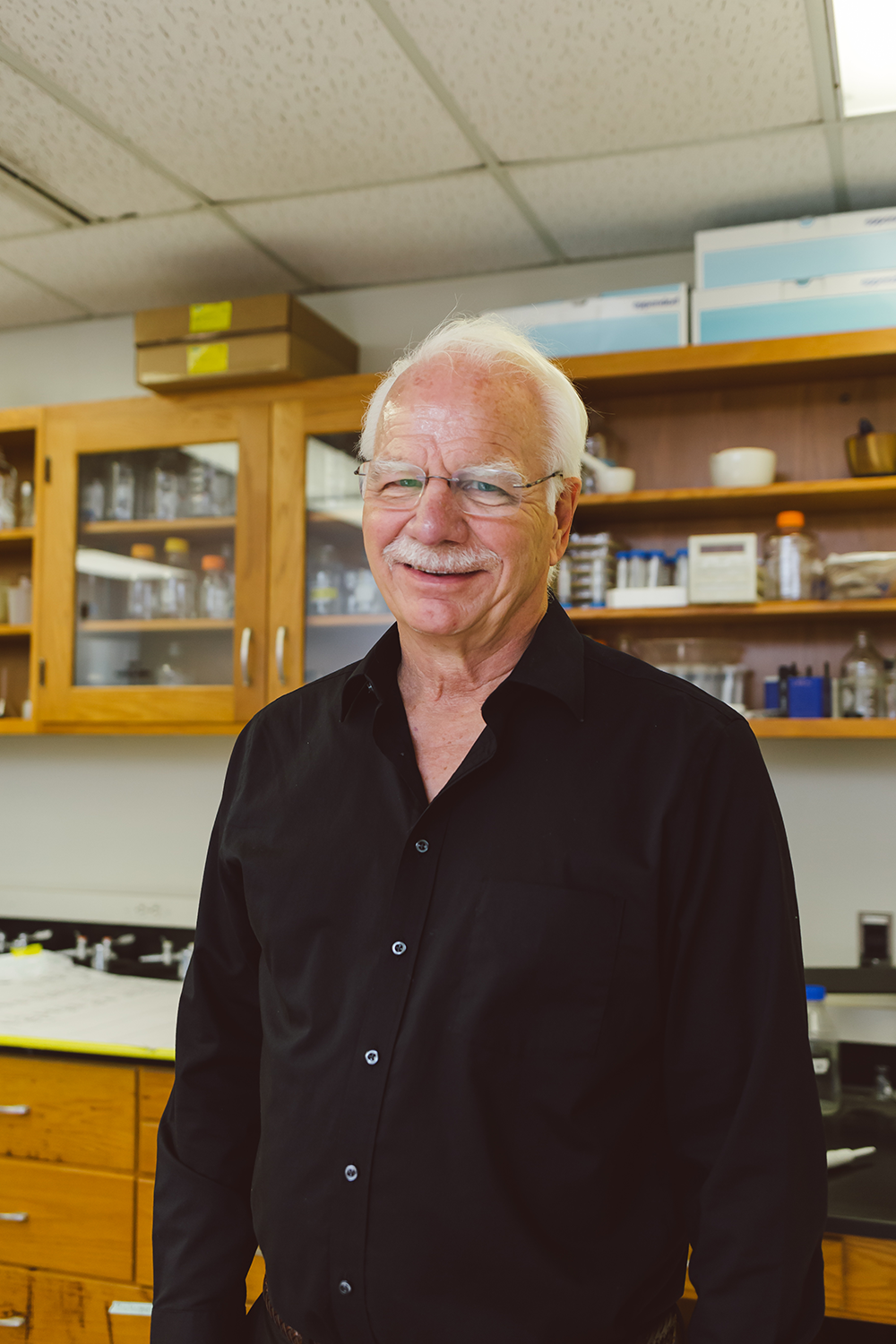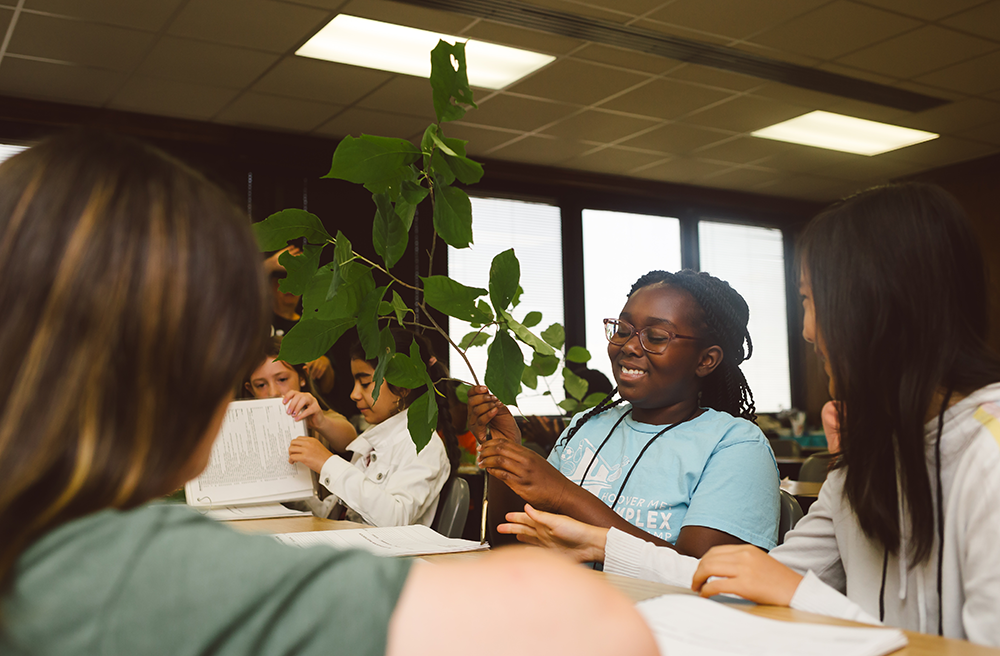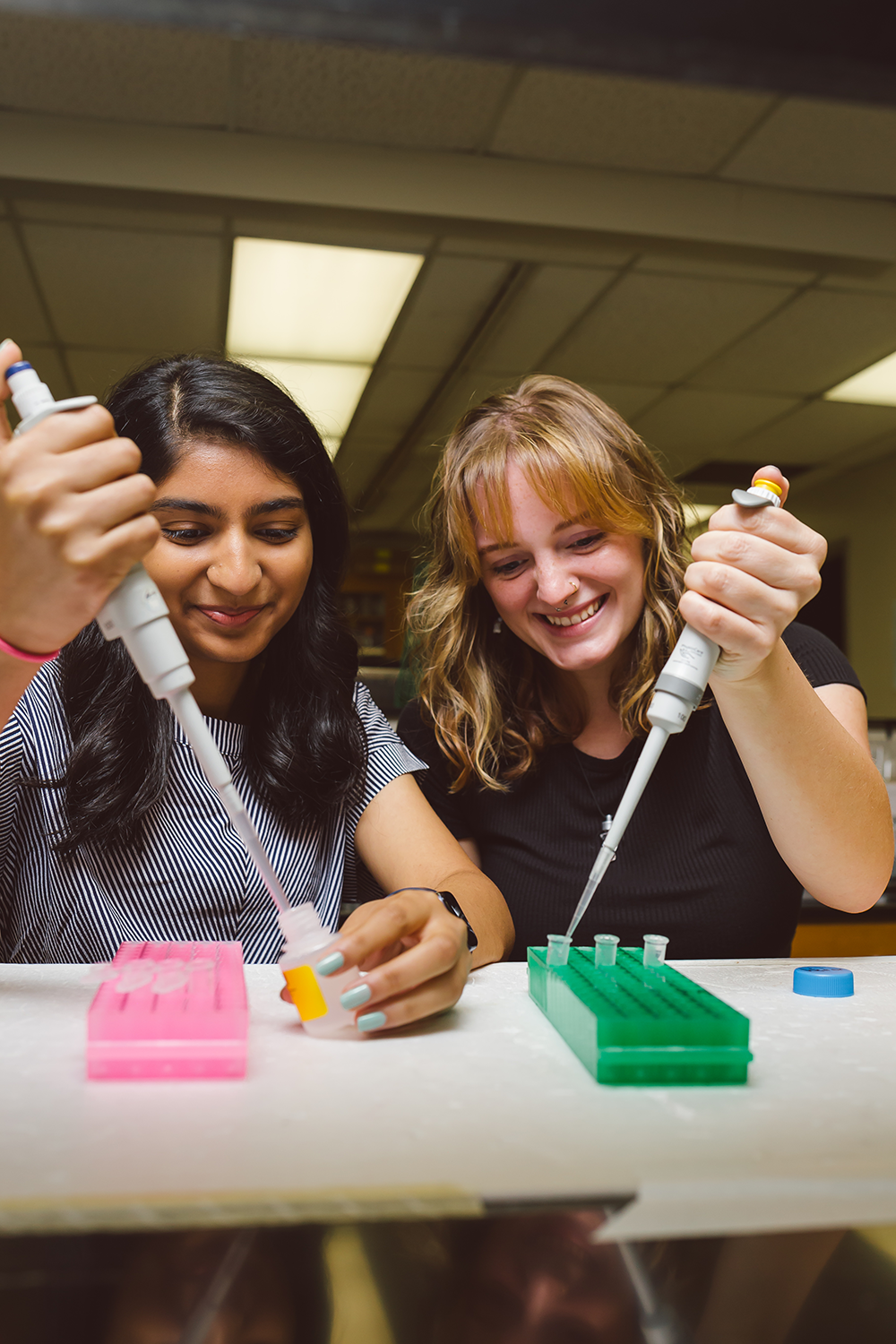The smartest playground in town takes place each summer at the Community Health Services Building on the campus of the University of Alabama at Birmingham. That is where hundreds of students ranging from third graders through high schoolers gather to scientifically examine leafy tree branches and food products and even vials of blood. And have fun while doing it.
Welcome to the educational programs of the UAB Center for Community OutReach Development (CORD), a center within the College of Arts and Sciences. Since 1998, CORD has strived to show young students that the world of science and math—with all its daunting formulas and fractions—can be both educational and entertaining, with a larger goal of perhaps sparking long-term career interest in those fields.
“A lot of times, these kids just don’t see themselves as belonging in these types of professions, like forensic science,” says CORD director Michael Wyss, Ph.D., a professor in the departments of Biology and Psychology at the UAB College of Arts and Sciences. “These programs help them understand that they can actually do these things. That they could be a scientist one day.”
 CORD Director Michael Wyss, Ph.D., a professor in the departments of Biology and Psychology at the UAB College of Arts and Sciences. So in one room, students scrutinize branches and twigs to determine the tree of origin. In another, they figure out blood types to find the right donation match for a fictional patient. And in a third, they analyze data related to the nutrient values in various food products.
CORD Director Michael Wyss, Ph.D., a professor in the departments of Biology and Psychology at the UAB College of Arts and Sciences. So in one room, students scrutinize branches and twigs to determine the tree of origin. In another, they figure out blood types to find the right donation match for a fictional patient. And in a third, they analyze data related to the nutrient values in various food products.
“A lot of schools don’t offer many labs with hands-on science,” says CORD program director Kevin Jarrett, who received a master’s in biotechnology from UAB in 2010. “So when the students come to our programs and get to do these hands-on laboratory experiments, they realize it’s not some incredibly difficult concept that they don’t understand. And that increases their confidence and belonging in science.”
The key, Wyss says, Is to make the CORD classwork as enjoyable as possible. “We want these camps to help show students what fun hands-on science and math can be,” Wyss says. “So when they go back to the classroom, they’re excited about it.”
Getting students excited in the STEM subjects (science, technology, engineering, and mathematics) is important because the number of employees needed in those fields is expected to increase 10.8 percent by the end of this decade, according to data from the U.S. Bureau of Labor Statistics.
In addition, Wyss points out that scientific knowledge is evolving so rapidly that many new advancements are out of date within 10 years. This means important discoveries that take place when students are in elementary school already could be irrelevant by the time they reach college, placing added importance on constant STEM instruction.
“If you don’t engage kids early and keep them engaged, they have a tendency to lose interest in science, math, and engineering as they get older,” Wyss says. “So we want to keep them interested in STEM, and make them realize that they can belong in these careers that they might not have even thought about otherwise. That’s what CORD is all about.”
Many of UAB’s predecessor programs to CORD began under Terry Hickey, Ph.D., former director of the UAB Vision Science Research Center in the 1980s and associate provost for academic programs from 1995 to 1997. CORD officially was formed in 1998, and ever since then, a primary component of the program has been an eight-week-long summer internship to prepare high school students for college and potential biomedical research careers.
“We take mostly students from Birmingham City Schools along with some other area school districts,” Wyss says. “They spend 40 hours a week in the lab of a PI (principal investigator), who helps train them. Almost 100 percent of the interns earn an undergrad degree within five years, and most of them have gone on to grad school.”
In 2004, the focus of CORD was expanded to include all K-12 students—especially those from underserved school systems—as well as educational subjects from throughout the STEM spectrum. In addition to the lengthier internships for high schoolers, CORD began offering week-long camps for students of all ages, highlighted by the Summer Science Institute (SSI) with its emphasis on making STEM fun.
They get to see what's offered at UAB, and experience a little bit of the student life."
Kevin Jarrett
“All our camps are geared toward moving these students on to the next year of school,” Wyss says. “So the first things they’re being taught when they return to school, they’ve already learned some of that over the summer with us.”
For example, Wyss says one of the areas of focus for rising seventh graders involves biology, genetics, and physiology. So during the SSI camps, those students participate in projects and experiments illustrating such topics as the workings of the cardiovascular system and the importance of blood-pressure readings.
“For fifth graders, we’re teaching them what pH is,” Wyss says. “I had a father come in to pick up his child one day and he said, ‘I have to thank you. My kid taught me what pH and acidity are.’ That was great. Now you have the students becoming teachers and helping their parents understand science.”
For many high schoolers, the SSI experience is coupled with a tour of the UAB campus. Through the GearUp Jefferson County program, students still participate in the lab work, but they also receive an up-close view of what a college campus is all about.
“They get to see what’s offered at UAB, and experience a little bit of the student life,” Jarrett says. “A lot of them leave wanting to go to college and take these classes, because now they feel like it’s something they can do.”
 CORD also offers year-round programs for approximately 65,000 Birmingham-area students in connection with AMSTI (Alabama Math, Science, and Technology Initiative) and ASiM (Alabama Science in Motion). In addition, up to 3,000 students participate each year in CORD’s GENEius Lab (which focuses on molecular biology and genetics) and LabWorks (biology, chemistry, and physics) held at McWane Science Center.
CORD also offers year-round programs for approximately 65,000 Birmingham-area students in connection with AMSTI (Alabama Math, Science, and Technology Initiative) and ASiM (Alabama Science in Motion). In addition, up to 3,000 students participate each year in CORD’s GENEius Lab (which focuses on molecular biology and genetics) and LabWorks (biology, chemistry, and physics) held at McWane Science Center.
All these programs are made possible by a wide variety of grants, donations, and other funding, including through the National Institutes of Health, the National Science Foundation, the U.S. Department of Education, and the NIH Science Education Partnership Award program.
“Often there is not enough support for science in the nation,” Wyss says. “We want CORD to help people understand that investing in science and technology can lead to a very promising future for all.”
Of course, the children can’t learn without teachers. For that, CORD relies on assistance from the Birmingham City School District as well as approximately 350 current UAB students to provide instruction for the various camps and programs
Kathryn Terry Mims, a fifth-grade teacher at Oliver Elementary School, has been working with CORD since 2010. For this year’s Summer Science Camps, she led a week-long examination of the natural environment and the factors that affect it.
One day was spent solely on soil, determining the components and pH of soil samples. Then a day was reserved for discussing insects and animals, ranging from macroinvertebrates (snails, worms) to birds of prey (owls, hawks). That was followed by tree day (which was when the hickory and oak branches were brought into the classroom) and water day (comparing rainwater, tap water, and filtered water).
“They have a hands-on lab every day with several activities,” Mims says. “I provide them the background content, then they work through the assignment on their own. It’s all hands-on, instead of just identifying things in a book. If they can feel it and touch, they’re more likely to remember it.”
CORD has been around for so long and been so successful—in 2019 the program received the Presidential Award for Excellence in Science, Mathematics and Engineering Mentoring—that many former SSI attendees have returned as UAB students to teach CORD classes to a new generation.
That is the case for Mary Elisa Wagner, a biology major who is beginning her senior year at UAB. Wagner attended SSI camps while a student at The Altamont School, and she says her interest in science increased after being involved with a project involving a crime-scene scenario.
“We had this made-up story where there were five suspects, and we had to do a DNA analysis to figure out who did it,” says Wagner, whose mother is the former director of the GENEius Lab. “It helped me understand the science better and made it more interesting. Now I get to create those types of stories for these students.”
Vestavia Hills High School graduate Anushka Patel had a similar experience. She says her career considerations grew after she began going through the SSI camps before her seventh-grade year.
“First, just the exposure I received to STEM—and enjoying those experiences—helped me consider a career in science,” Patel says. “Then we had a variety of speakers come in, and that opened me up to different medical professions.
“A lot of time we only think about physicians and nurses. But we had genetic counselors and researchers and biomedical engineers speak to us. Different fields that I hadn’t really thought about before CORD. So learning about all the various fields that are available in STEM was something that CORD exposed me to.”
Now Patel is entering her junior year at UAB as a neuroscience major. And like Wagner, she has returned to CORD as a teacher.
“I really want to give back to the community, and teaching is a passion of mine,” Patel says. “The facilitators I had when I did these camps really made a huge impact on me. I want to give back to these kids and share some of my experiences, so maybe they’re interested in pursuing a career in STEM.”
We want them to understand the promise of science, and help put them in to positions where they can move forward in careers in STEM."
Michael Wyss
 From left to right: Anushka Patel, a UAB junior studying neuroscience, and Mary Elisa Wagner, a UAB senior studying biology, both participated in CORD programs as high school students.
From left to right: Anushka Patel, a UAB junior studying neuroscience, and Mary Elisa Wagner, a UAB senior studying biology, both participated in CORD programs as high school students.
Wyss says he has witnessed numerous examples over the years of the connection that CORD can have with young students, and the ability of the program to, as he puts it, “change lives.” Two such examples stand out.
One involved a rising sixth-grader who took part in CORD’s “Over the Hills” camp, which focuses on environmental sciences. At the end of each day, the students were supposed to work on personal computers to document what they had learned, then use that documentation to produce a PowerPoint presentation they would show to their family members.
Wyss says he noticed one student seemed reluctant to use the computer. When Wyss asked him why, the student said he was unable to spell many of the words being discussed in the class and was embarrassed to try.
“So I showed him how to use spell checker, and he showed me how to animate the slides,” Wyss says. “After three days of working together, he presented a great PowerPoint to his mother and grandmother on the closing day of the camp. He attended CORD programs for the next five years and is currently in college at UAB.”
The other involved a sixth-grader whose family support system was not strong. He was a D-level student in middle school, and Wyss says his teachers were doubtful whether he would remain enrolled through high school graduation.
The student’s disinterest was obvious at the beginning of the CORD camp, but Wyss says the UAB facilitators worked closely with him, and he began to enjoy the experience. Wyss says he went on to become a B-level student, and also eventually enrolled at UAB.
“So many of these kids haven’t really looked at these careers as being opportunities for them,” Wyss says. “We want them to understand the promise of science, and help put them into positions where they can move forward in careers in STEM.”
CORD has been getting students plugged into such possibilities for the past 25 years. It is a connection that benefits all those involved, both the learners and the teachers
“I’ve enjoyed being able to show these kids that STEM is really wonderful,” Patel says. “It’s amazing when you work with a kid on a project and you see that they’re starting to understand it. That is such a rewarding experience.”


